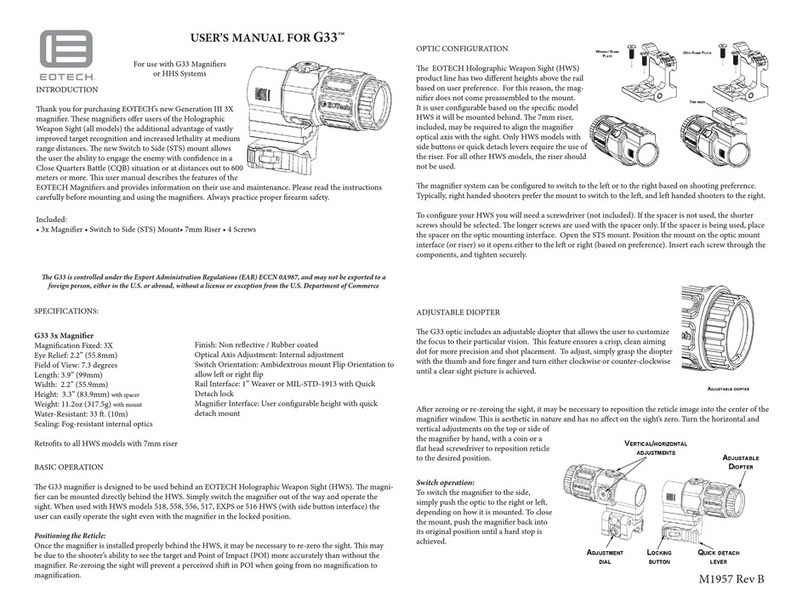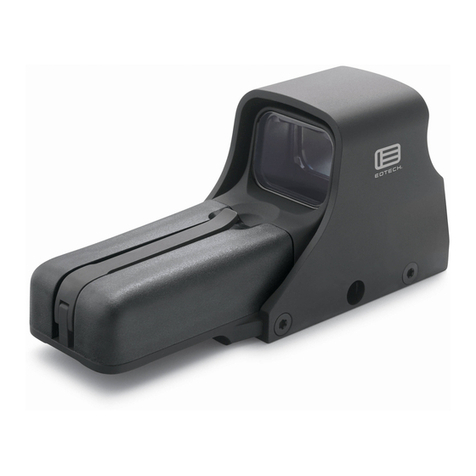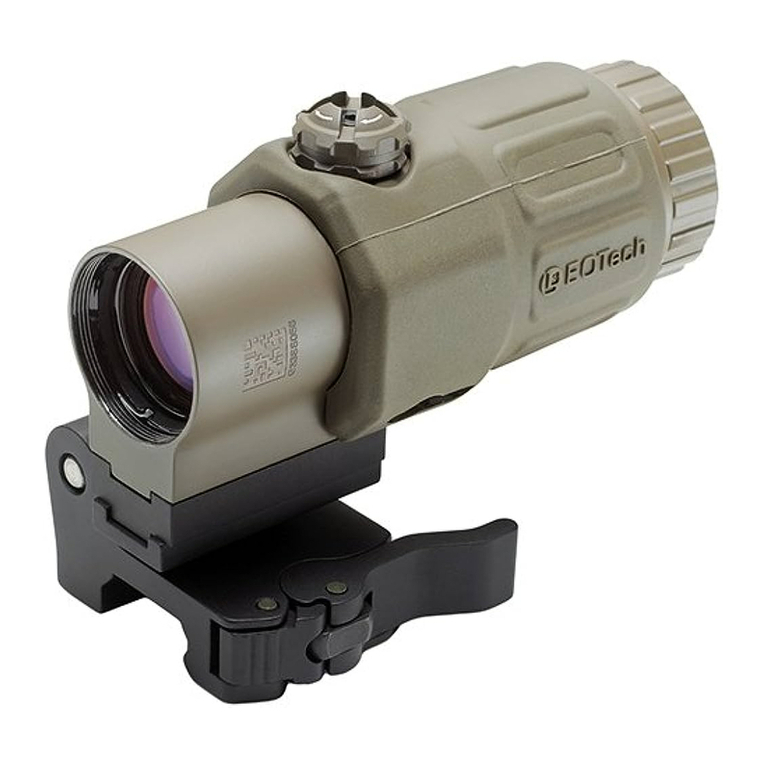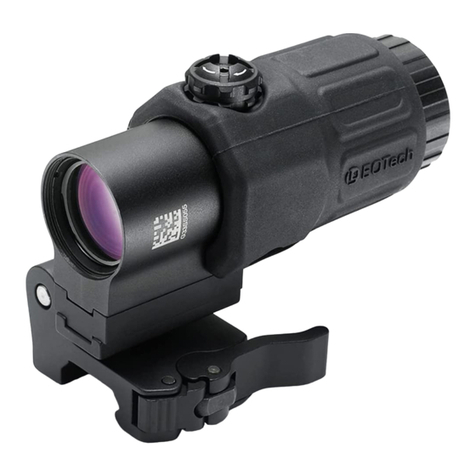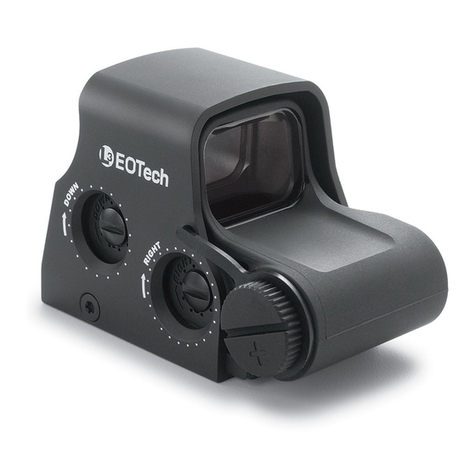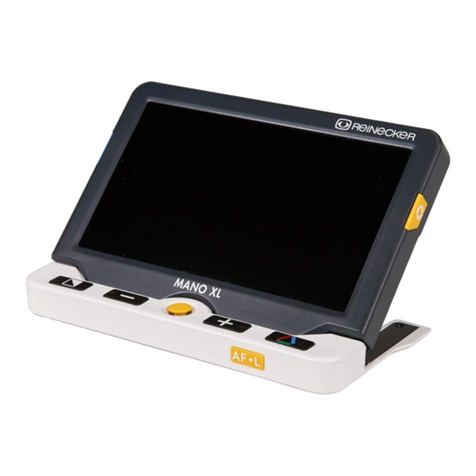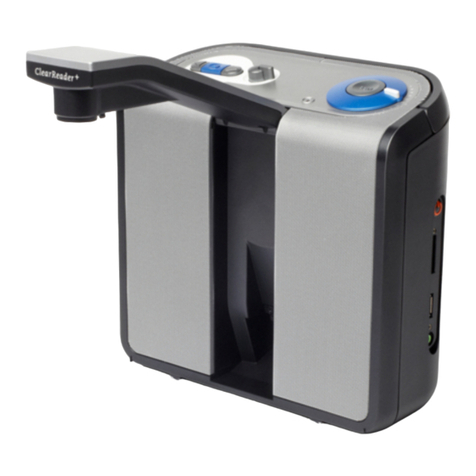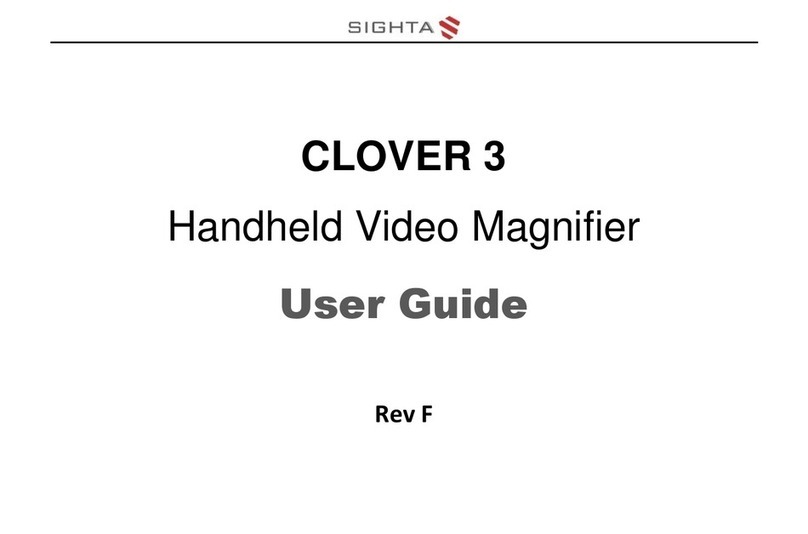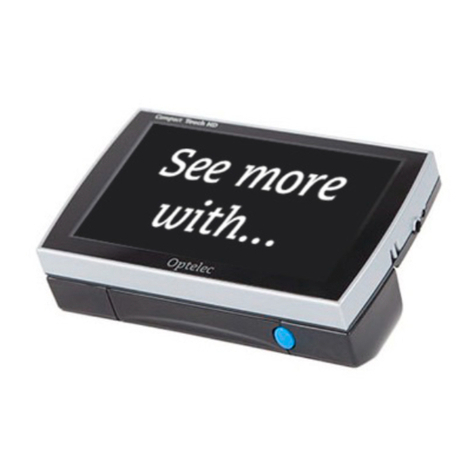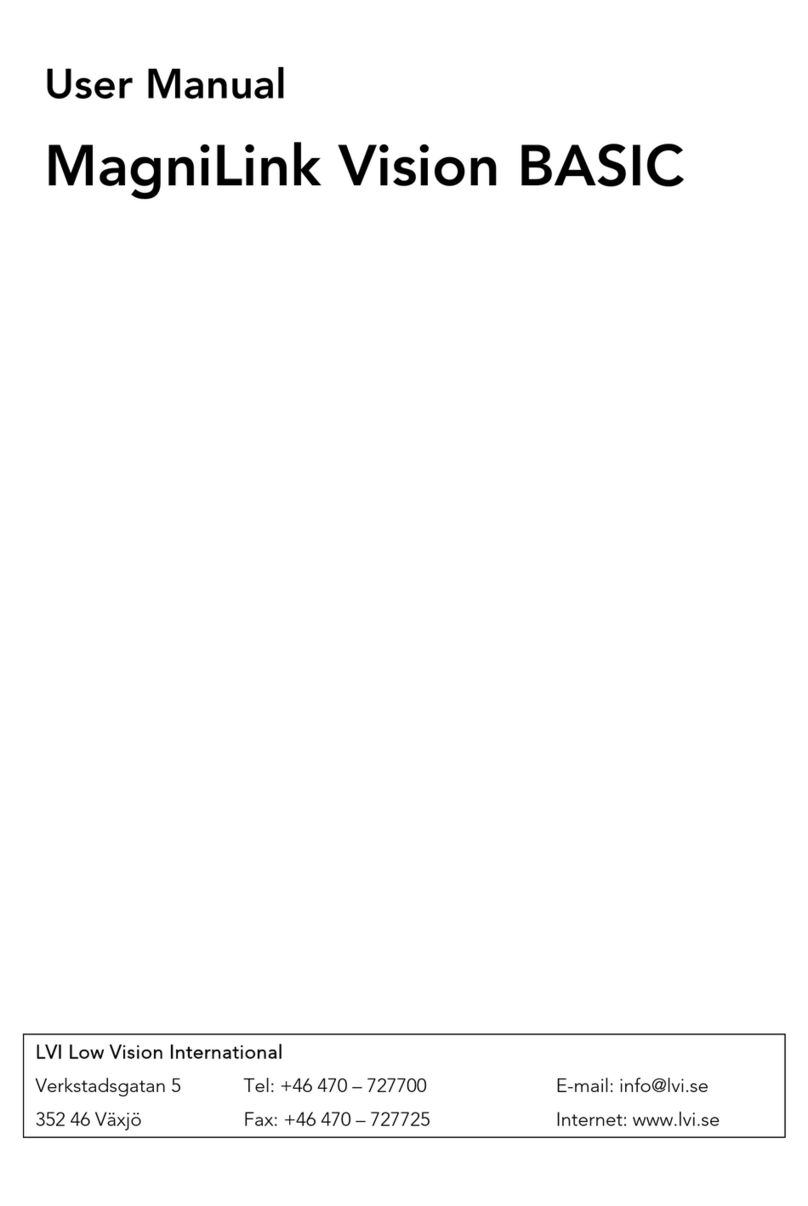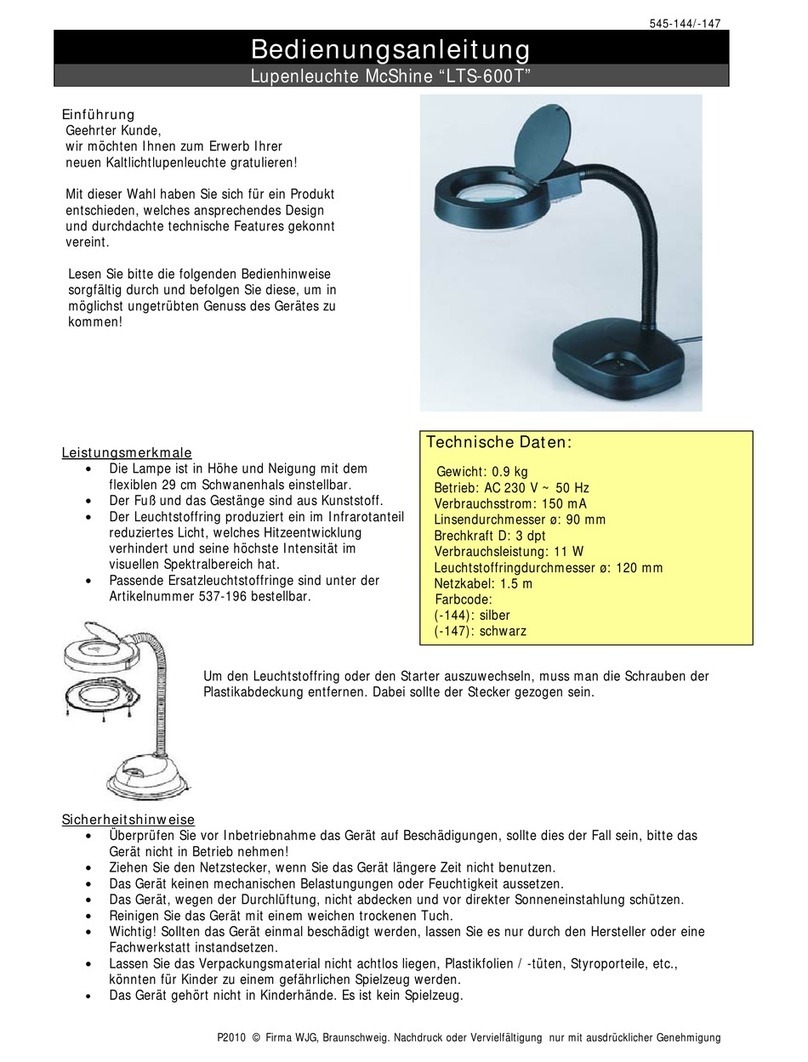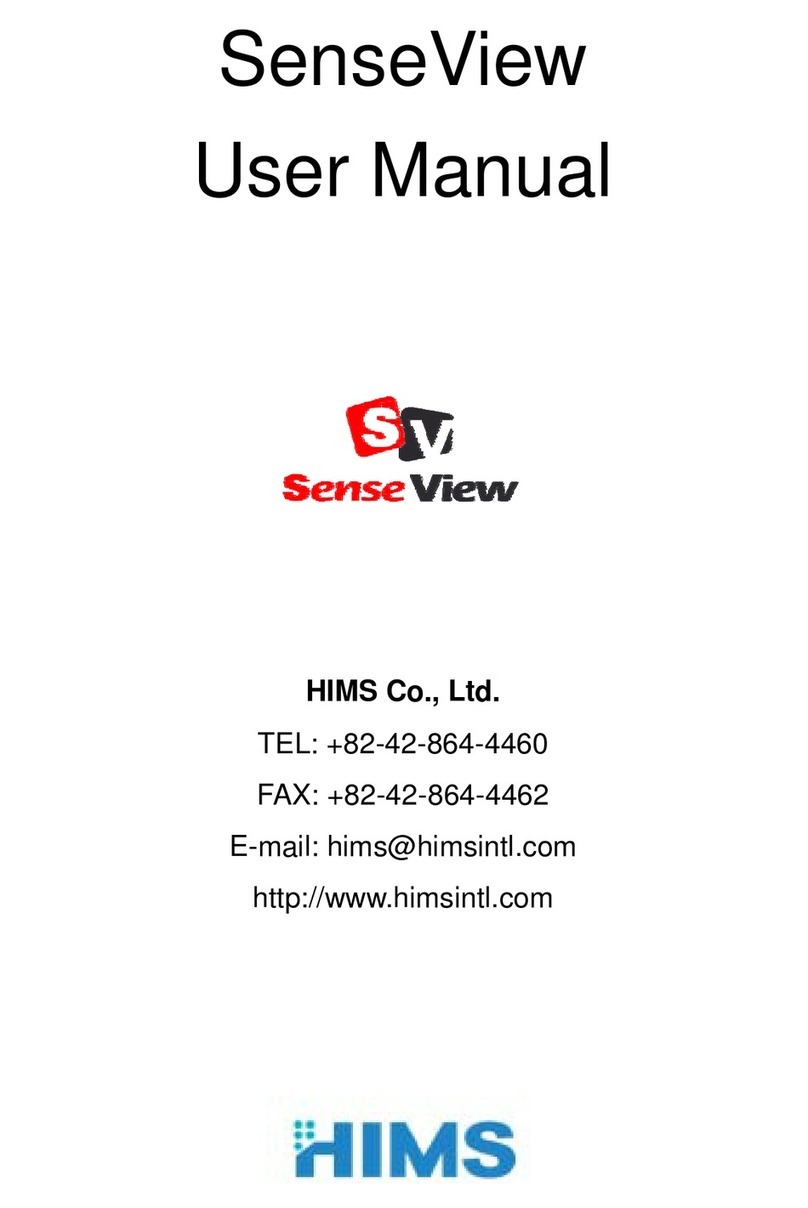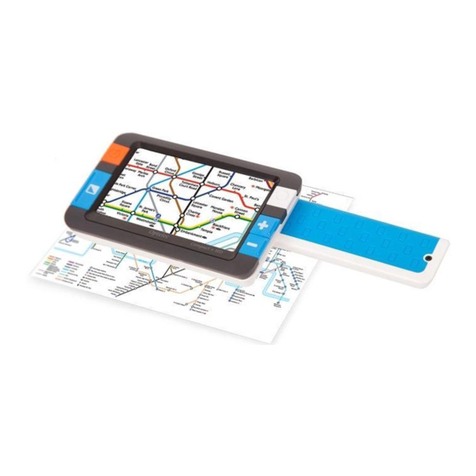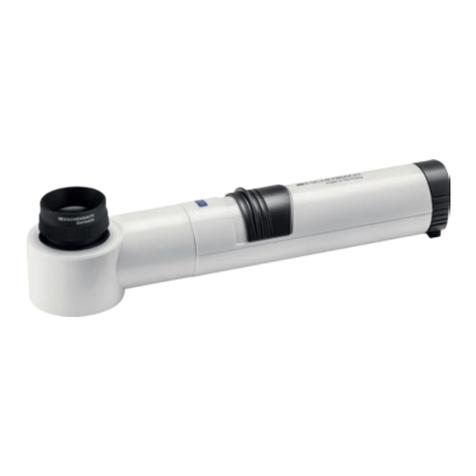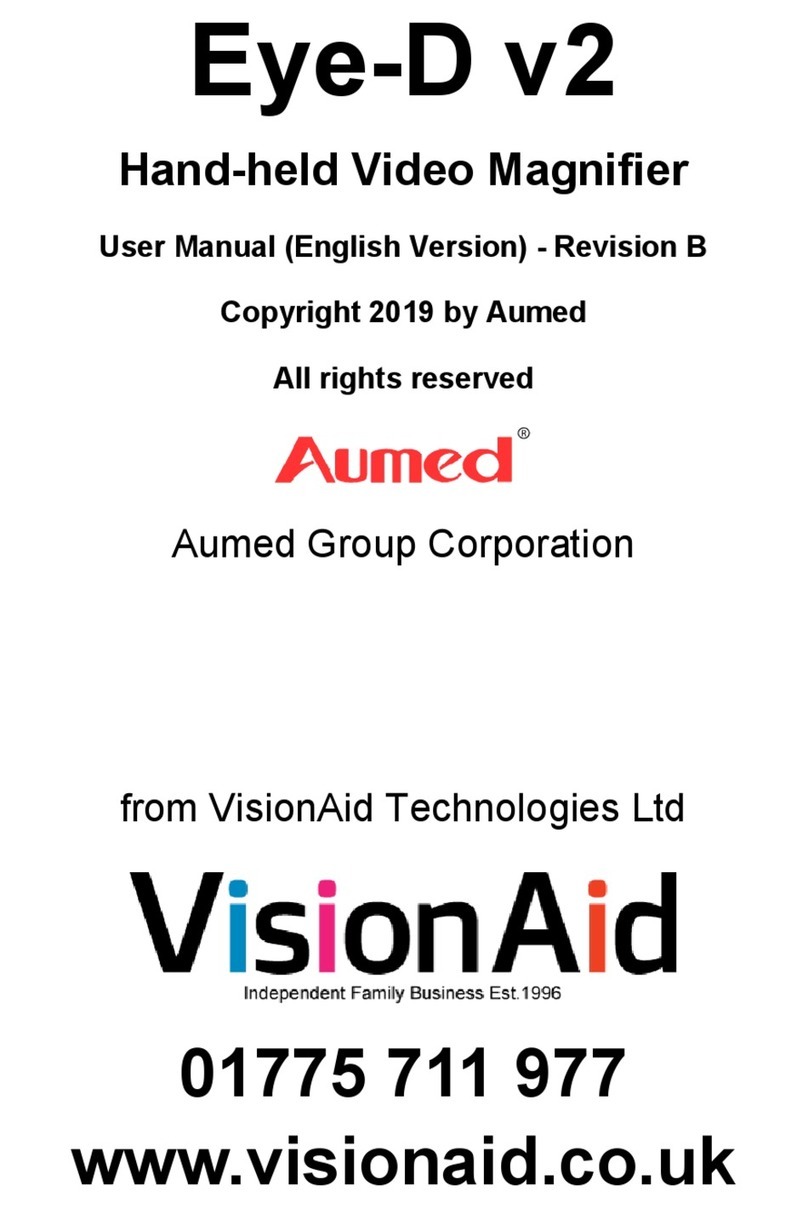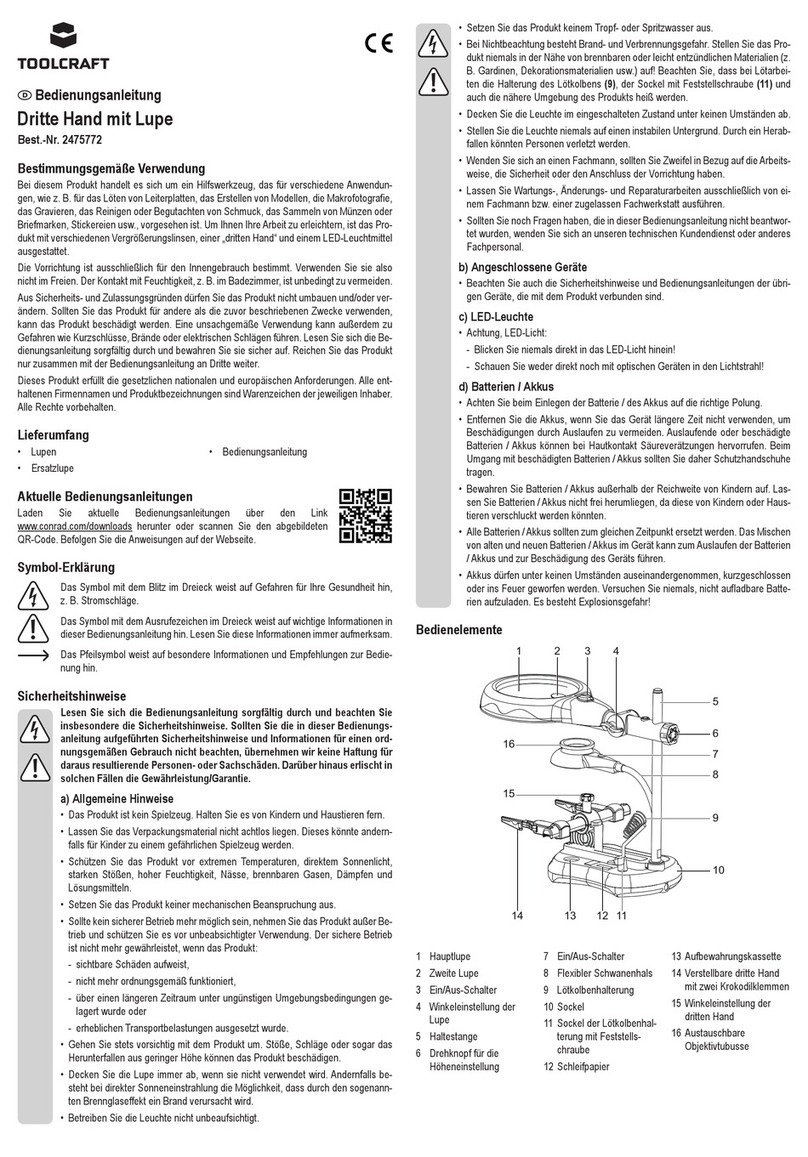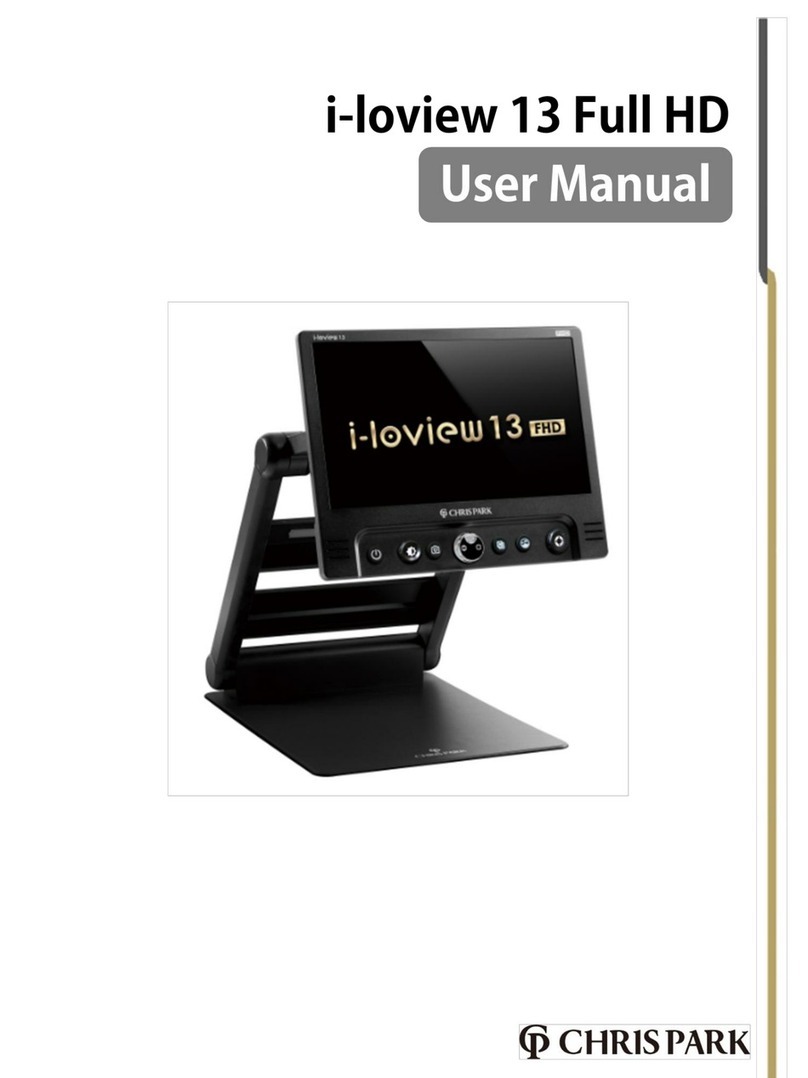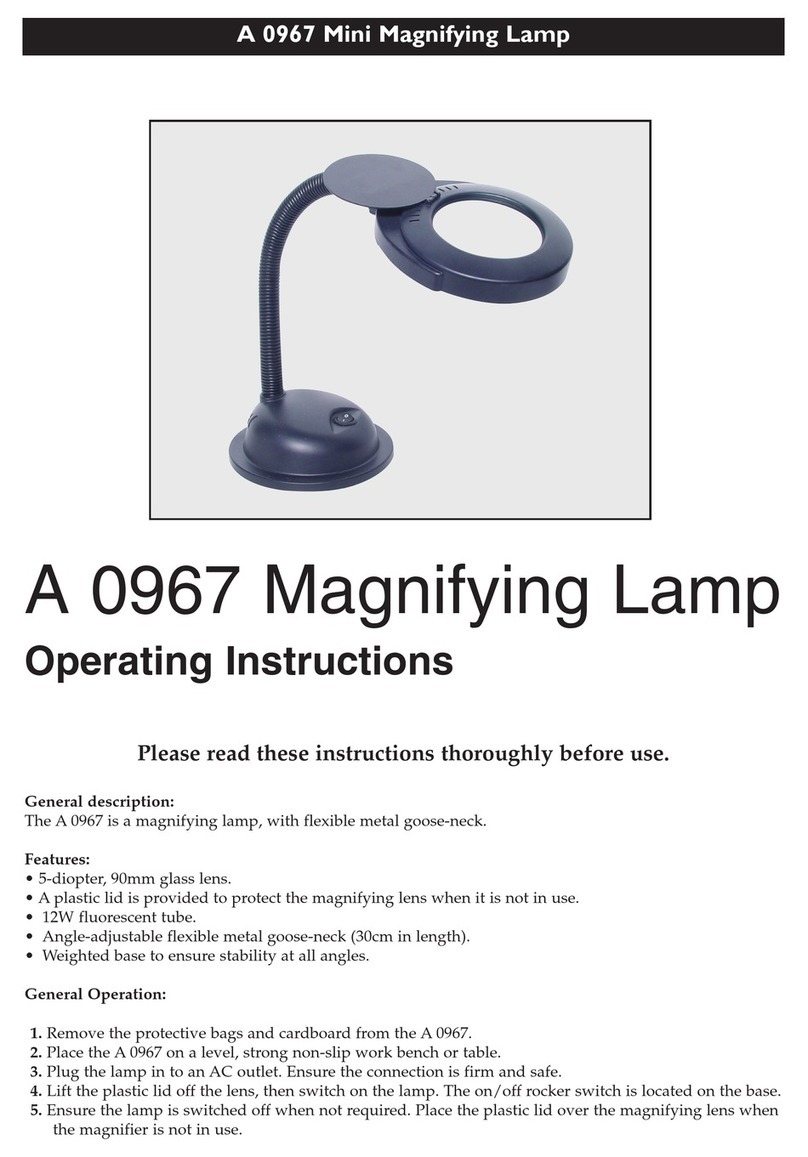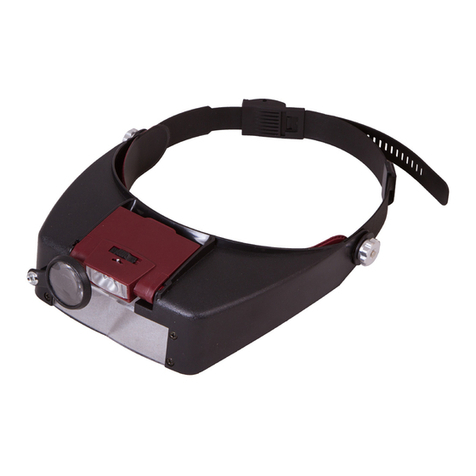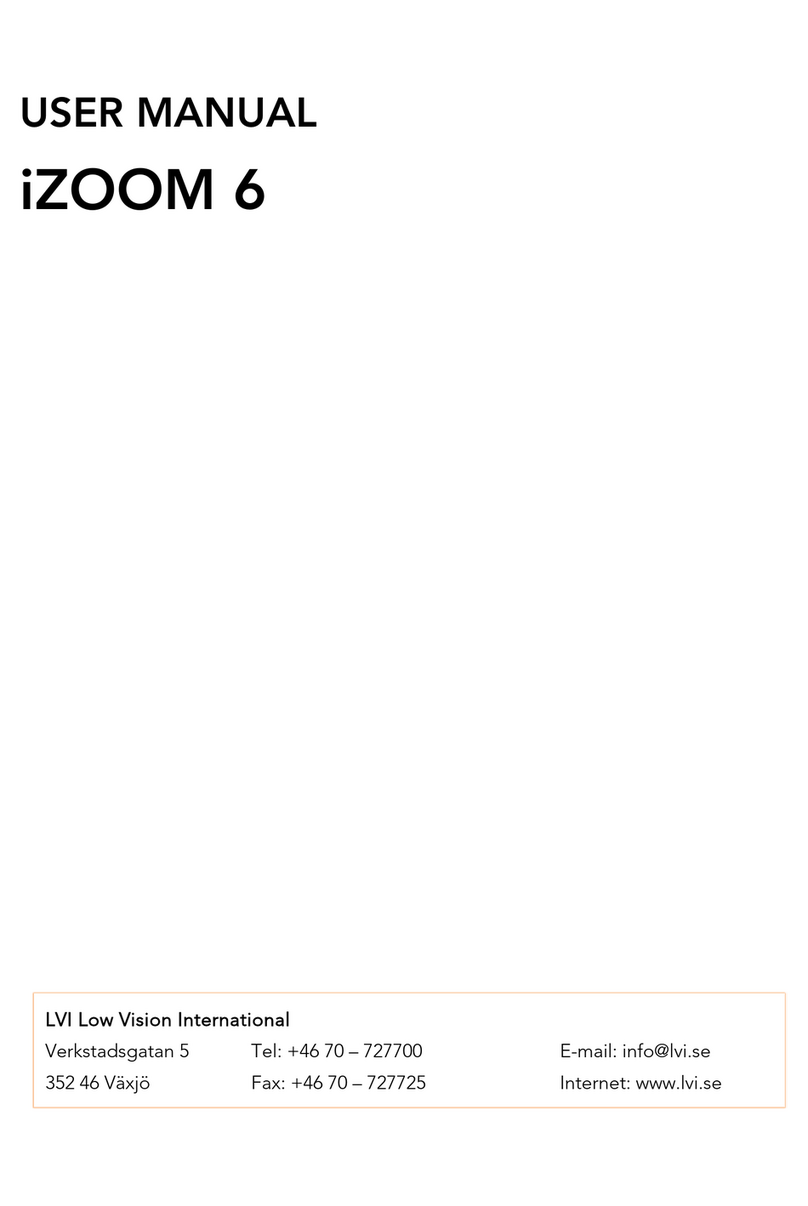EOTech 552 User manual

1
552™
HWS®(HOLOGRAPHIC WEAPON SIGHT)

THIS PAGE WAS LEFT BLANK INTENTIONALLY

3EOTECHINC.COM /
Contents
1 /SHOW SOME RESPECT
Distribution Statement . . . . . . . . . . . . . . . . . . . . . . . . . . . . . . . . .4
Warnings . . . . . . . . . . . . . . . . . . . . . . . . . . . . . . . . . . . . . . . .4
Caution . . . . . . . . . . . . . . . . . . . . . . . . . . . . . . . . . . . . . . . . .5
2 /THE BASICS
General Info . . . . . . . . . . . . . . . . . . . . . . . . . . . . . . . . . . . . . . .6
Key Attributes. . . . . . . . . . . . . . . . . . . . . . . . . . . . . . . . . . . . . .6
Reticles . . . . . . . . . . . . . . . . . . . . . . . . . . . . . . . . . . . . . . . . .8
Specifications . . . . . . . . . . . . . . . . . . . . . . . . . . . . . . . . . . . . . .9
Anatomy . . . . . . . . . . . . . . . . . . . . . . . . . . . . . . . . . . . . . . . . 10
Definitions . . . . . . . . . . . . . . . . . . . . . . . . . . . . . . . . . . . . . . . 11
3 /GET STARTED
Operating Instructions . . . . . . . . . . . . . . . . . . . . . . . . . . . . . . . . 12
Mounting the HWS . . . . . . . . . . . . . . . . . . . . . . . . . . . . . . . . . . 13
Battery. . . . . . . . . . . . . . . . . . . . . . . . . . . . . . . . . . . . . . . . . 14
Battery Recommendations
Replacing the Battery
Electronic Features . . . . . . . . . . . . . . . . . . . . . . . . . . . . . . . . . . 16
Night Vision Mode . . . . . . . . . . . . . . . . . . . . . . . . . . . . . . . . . . 17
Windage and Elevation . . . . . . . . . . . . . . . . . . . . . . . . . . . . . . . . 18
Zeroing Procedures . . . . . . . . . . . . . . . . . . . . . . . . . . . . . . . . . 19
4 /MAINTENANCE
Cleaning Instructions . . . . . . . . . . . . . . . . . . . . . . . . . . . . . . . . 20
Operator Level Maintenance. . . . . . . . . . . . . . . . . . . . . . . . . . . . . 21
Troubleshooting. . . . . . . . . . . . . . . . . . . . . . . . . . . . . . . . . . . .22
5 /NEED SOME HELP?
Service and Repair . . . . . . . . . . . . . . . . . . . . . . . . . . . . . . . . . . 24
Replacement Items . . . . . . . . . . . . . . . . . . . . . . . . . . . . . . . . . .24
Contact Information . . . . . . . . . . . . . . . . . . . . . . . . . . . . . . . . . 25

4/ 552
1/ SHOW SOME RESPECT
Distribution Statement
Approved for public release; distribution is unlimited.
This commodity is controlled under the Export Administration Regulations (EAR),
ECCN 0A504.b, and may not be exported to a Foreign Person, either U.S. or abroad,
without a license or exception from the U.S. Department of Commerce.
Warnings
Weapon Safety
Prior to mounting the HWS on your weapon, be sure the weapon is cleared.
If you are not sure how to clear your weapon, please see the operator’s manual
that accompanied the weapon platform you are mounting the sight on.
Laser Safety
The HWS is a Class I laser product. The illuminating beam
can become accessible to the eye if the housing is broken.
Turn the sight off immediately and return the broken unit
to the factory for repair.
FCC Compliance
The HWS complies with Part 15 of the FCC Rules. Operation is subject to the
following conditions: (1) this device may not cause harmful interference and (2) this
device must accept any interference received, including interference that may cause
undesired operation. Complies with 21 CFR Chapter 1, Subchapter J.

5/ 552 EOTECHINC.COM /
SHOW SOME RESPECT / 1
Caution
Never disassemble the sight’s optical assembly. The optical cavity is purged,
nitrogen filled, and sealed to achieve fog-resistant performance. Disassembly
will void the warranty and render the sight inoperable.
Ensure the HWS is off before using night vision mode. Once the sight is OFF,
pressing the NV button activates the NV mode for use with an HWS in tandem
with a night vision device. Brightness settings in NV mode are only detectable
when using night vision.
When a sudden increase in resistance is felt in the elevation or windage
adjustment shafts, the end of the adjustment range has been reached. DO NOT
TURN THE ADJUSTMENTS ANY FARTHER OR SERIOUS DAMAGE MAY OCCUR
TO THE SIGHT.
Always dampen the glass surfaces prior to cleaning. Never clean the glass
surface with a dry cloth or paper towel.
All moving parts of the sight are permanently lubricated. Do not try to
lubricate them.
Do not use deteriorated or corroded batteries. Inspect batteries for rips, tears,
dents, or cuts in the battery housing. If there is any exposed internal content of
the battery, it could affect the operation of the sight.
The 552 HWS units are designed to mount directly to either a 1" (25.4mm)
Weaver or MIL-STD-1913 rail specification.

2/ THE BASICS
6/ 552
General Info
This manual is an overview of the 552 HWS (Holographic Weapon Sight), and will
define the basic operation, features/benefits, and options of this proprietary optical
system. The HWS is a state of-the-art optical sighting system, employing holographic
sighting technology for small to medium caliber weaponry and launching type plat-
forms. The HWS utilizes holographic optics fabrication technology that is used in
the production of advanced heads up display in attack fighter aircraft for targeting,
gauge reading, weapon system verification, etc. EOTECH®has miniaturized the
sophisticated sighting heads up display system into a compact and rugged package
for use on small arms and other weapon platforms.
Key Attributes
The 552 HWS is a lightweight, non-magnifying, optical sight designed for close to
midrange engagements. It allows very fast target acquisition and engagement at
short ranges while providing aiming capability out to 300 meters equal to or better
than iron sights.
The major combat advantage of the HWS is extremely rapid reticle-on-target
acquisition. As quickly as a target is identified, the holographic reticle can be
superimposed on the target. The sight allows operators to maintain eye contact on
the target and to place the holographic reticle onto the target without shifting focus.
Operators can quickly acquire the target and reticle in the same focal plane for fast
and accurate shot placement.
The HWS appears to project the holographic image of a reticle on the target plane.
The sight can be used as a bright open reticle image or a fine dot. The heads-up
display window allows an undistorted and unrestricted view of the target.
The HWS offers extremely fast target acquisition in Close-Quarters Battle (CQB)
using the large ring, and aiming precision in longer range engagements (using the
MOA Dot) without obscuring the target.

THE BASICS / 2
7/ 552 EOTECHINC.COM /
Another advantage of the HWS is the full field of view which allows the operator
better situational awareness. The HWS employs a true heads-up display (HUD)
window that eliminates blind spots and constricted or tunnel vision associated with
scope sights. Controls are inset into the HWS housing with no protruding knobs,
battery compartments, or rings obscuring the target. Utilizing natural binocular vision
is an advantage of this sighting system, as well as additional threat identification
through increased operator situational awareness and peripheral vision.
The 552 can operate in tandem with Generation I – III+ night vision intensifier
tubes. Operators can see the holographic reticle image with helmet mounted or
weapon mounted night vision devices. The HWS is a passive system and emits no
signature from frontal or from a peripheral aspect. While in the NV mode, the sight is
undetectable by opposing force night vision equipment. The HWS can be positioned
behind night vision systems without any “bloom” on the target area.
The primary use of the HWS is for the M4A1 carbine and CQBR in Close-Quarters
Battle. The HWS is not however, limited to carbines. The HWS can also be used on
medium caliber machine guns, grenade launchers, bolt guns, crossbows, MSR and
similar platforms, and less than lethal projectile launchers. The sight provides a 1X
(no magnification) sight picture and is not designed as a long range sight system;
however, it can be used as effectively as iron sights on targets to 300 meters.
The advantage of the HWS is that it provides the operator superior shooting
performance, rapid reticle-on-target acquisition, full field of view and accurate shot
placement. The HWS can be naturally deployed by all levels of users, from novice to
the most highly trained operator.

2/ THE BASICS
8/ 552
0 RETICLE
The 68 MOA ring with 1 MOA dot is ideal for fast target
acquisition. It provides three usable aiming points. The
aiming points above were based on the following load:
.223 Cal. 62 Gr. 2,900 Vel. Other loads and calibers can
also be used, but the operator will have to establish the
ranges associated with the aiming points. When using a
shotgun, the 68 MOA ring can be used to represent shot
patterns, but will vary based on choke and shell selection.
XR308 RETICLE
The XR308 reticle was designed specifically for the
military M240 machine gun. It was calculated with a
.308 Cal. with 150 Gr. M59 FMJ at roughly 2,800 fps
with a 24.8” barrel.
Reticles
HWS RETICLE ADVANTAGE
EOTECH’s Holographic technology provides a distinct advantage over typical red
dots. EOTECH can offer any type of reticle pattern, as opposed to being limited to
a single dot. EOTECH reticle designs are fabricated so that they can incorporate
multiple trajectory points of aim, range assist features, and anti-torque or cant
visual indicators.
HWS RETICLE PATTERNS
EOTECH’s reticle patterns greatly impact accuracy and fast target acquisition.
EOTECH’s reticle patterns feature a 68 MOA ring surrounding a 1 MOA center dot,
allowing the shooter to quickly pick up a target; HWS allows for more complex
reticle designs with minimal parallax error.
50 yds.
and
200 yds.
7 yds.
.9
.6
.12

THE BASICS / 2
9/ 552 EOTECHINC.COM /
Specifications
TECHNICAL SPECS
Optics Transmission holography
Magnification 1X
Eye Relief Unlimited
L × W × H 5.6" × 2" × 2.5" (142.2 × 50.8 × 63.5mm)
Weight 11.5 oz (326g)
Water Resistant 33 ft (10m) depth
Sealing Fog-resistant internal optics
Color/Finish Black
Adjustment (Per Click) Approx. 0.5 MOA [1/2" (12.7mm) at 100 yds. (91m)] when zeroing
Adjustment Range Range: +/- 40 MOA travel
Mount 1" Weaver or MIL-STD 1913 rail
DISPLAY WINDOW
Optical Surfaces Anti-reflection coating on external surfaces
Window Dimensions 1.20" × 0.85" (30 × 23mm)
Front Window Material Glass 1/8" (3.17mm) thick
Rear Window Material Laminate 3/16" (4.76mm) thick
FOV 100 Yds (91m) 30 yds. (28m) at a 3" eye relief
Reticle Options 0- 68 MOA circle with quadrant ticks with 1 MOA aiming dot
XR308- (4) ballistic aiming dots designed around .308 caliber round
ELECTRICAL
Power Source 2 × 1.5 V AA batteries — Supports lithium, alkaline, or rechargeable
Battery Life Lithium: 2,500 continuous hours at nominal setting 12 at room temp.
Alkaline: 2,200 continuous hours at nominal setting 12 at room temp.
Brightness Settings 20 daylight settings
10 additional settings for Gen I through III+ night vision devices
Auto Battery Check Indicator Flashing reticle upon start-up
Auto Shut-Down At 8 hrs – programmable to 4 hrs

2/ THE BASICS
10 / 552
Anatomy
Holographic
Window
Reticle
Elevation
Adjustment
Windage
Adjustment
Protective
Aluminum Hood
Locking
Cam Lever
Removable
Battery
Compartment
Universal
Mount
On/Off, Night Vision
and Brightness Buttons

THE BASICS / 2
11/ 552 EOTECHINC.COM /
Definitions
Removable Battery Compartment
A battery cap secures and seals the battery compartment to prevent water,
dirt or grime from entering the battery housing.
Cam Lever
A cam lever that secures the removable battery compartment to the sight and
prevents water, dirt, or grime from entering the battery housing.
Holographic Window
Contains the embedded holographic reticle pattern that forms a virtual image of
the reticle when illuminated by laser light.
ON/OFF, Night Vision and Brightness Buttons
Raised button control interface allows the operator to perform and adjust user
settings for appropriate and preferred conditions (see page 16).
Protective Aluminum Hood
Preassembled protective hood increases durability of sight housing and protects
the sight from impact damage.
Universal Mount
Integrated base to accommodates all MIL-STD 1913 rail tolerances.
Elevation Adjustment
Adjusts the point of aim at 100 yards approximately ⁄" per click in an upward
and downward direction when zeroing.
Windage Adjustment
Adjusts the point of aim at 100 yards approximately ⁄" per click in a leftward
and rightward direction when zeroing.

3/ GET STARTED
12 / 552
<FRONTBACK >
Operating Instructions
This section describes the features and operating instructions of the 552.
Please read the instructions carefully before mounting and using the sight,
and always practice proper firearm safety.
The HWS will include:
• HWS 552 Sight
• 2 × AA Alkaline Batteries
• 7/64 Allen Key
• Quick Reference Card
• Product Registration/Warranty Card
• Hex Cross Bolt
PRO TIP: Sight shown (below) mounted to help identify front and back.

GET STARTED / 3
13/ 552 EOTECHINC.COM /
Mounting the HWS
The 552 is equipped with mounting hardware to attach to a 1" (25.4mm) Weaver
or MIL-STD-1913 Picatinny style rail (FIGURE 1).
To achieve the best results and accuracy, the HWS must be mounted properly. The
rail needs to be as parallel as possible to the bore to permit the maximum elevation
and windage adjustments.
PRO TIP: If required, it is strongly recommend that the rail be installed by a qualified gunsmith.
To mount the sight:
1. Turn the hex bolt counterclockwise to back the bolt out of the weaver lock.
Do not back the bolt all of the way out of the lock, only enough for the base to
sit properly on the rail.
2. Turn the hex bolt clockwise, drawing the weaver lock into the rail until resistance
is felt. Using a coin, (a U.S. nickel or similar size is recommended), rotate the bolt
head an additional 1/2 turn to fully tighten. This is equivalent to approximately
17 in-lb (0.2 kgm) of torque.
FIGURE 1
Underneath View of HWS 552

3/ GET STARTED
14 / 552
Battery
• Two initially supplied (2) AA alkaline batteries power the 552 HWS.
• The HWS is designed to maintain constant brightness at a particular setting as the
battery drains down. The reticle brightness will not fade as the battery runs down,
but rather, shut down abruptly.
• The first indication of the battery draining is the reticle blinking when the unit is
turned on (see Electronic Features, page 16).
• Another indication of a low battery is the reticle pattern blinking off and on during
recoil. With high recoil guns, this can occur before the battery check indicates low
battery condition.
• If the reticle pattern blinks off and on during recoil or turns off suddenly, replace
the battery.
PRO TIP: It is always good practice to replace the battery with a fresh ones before a mission.
Battery Recommendations
We recommend the use of Energizer™batteries with the 552 HWS.
• Alkaline AA batteries
Alkaline AA batteries from different manufacturers are not all constructed the
same way. Tests show some brands are more susceptible to degradation by the
shock of recoil.
• Lithium AA batteries
Lithium AA batteries offer longer life, particularly at temperatures below freezing.
For this reason Lithium batteries are recommended for cold weather operations.
The battery checking function, which is based on the characteristics of alkaline
batteries, does not operate properly when Lithium AA batteries are used in the
model 552 and may not indicate a low battery condition until very little battery
life is left.

GET STARTED / 3
15/ 552 EOTECHINC.COM /
Replacing the Battery
• Remove the battery compartment by lifting up on the locking cam lever and
carefully sliding the battery compartment away and up from the sight housing
(FIGURE 2).
• After the battery compartment is removed, slide the batteries out and replace
them with a fresh set. The labels on the bottom of battery compartment show the
correct battery orientation.
• Always make sure the gasket is free of dirt before the battery compartment is
reinstalled or the seal may be compromised.
• To reinstall the battery compartment, point the sight towards the ground and slide
battery compartment onto base.
• Make sure there is enough clearance between the contact and the batteries to
avoid bending the contacts.
• Hold the battery compartment down firmly against the base and close the
locking cam.
• Before you push down on cam lever, make sure the battery compartment sits all
the way down and is parallel to the base.
• Verify correct battery installation immediately by turning on the sight and checking
if the holographic reticle appears.
• If the batteries are left in the sight backwards, they will be drained of their power.
Locking
Cam Lever
FIGURE 2

3/ GET STARTED
16 / 552
ON / Auto Battery Check >
• Pressing the Up or Down Arrow buttons will turn the sight ON at Level 12.
• The sight will automatically perform a battery check every time it is turned on.
• The reticle will blink when the batteries have between 20 percent or less useful
life left.
OFF >
• To turn the sight off, simultaneously press both the UP and DOWN arrows.
• Verify that the sight is ON/OFF by looking through the window for the reticle.
Electronic Features
All electronic controls are via push buttons located at the rear of the unit housing
(FIGURE 3).
PRO TIP: To ensure proper operation of the pushbutton switches, always press firmly on the
center of the switch.
FIGURE 3
ON,
4 hr. Auto Shut Off,
Decrease Brightness
Off
ON,
8 hr. Auto Shut Off,
Increase Brightness
ON, 8 hr. Auto Shut Off,
NV Mode,
NV Mode Toggle

GET STARTED / 3
17/ 552 EOTECHINC.COM /
Brightness Adjustment >
• The push buttons vary the brightness intensity of the holographic reticle pattern.
• Pressing the UP or DOWN buttons will increase or decrease the brightness level.
• There are twenty (20) daytime brightness settings provided to allow the user to
adjust the reticle brightness to their preference.
Auto Shutdown >
• The HWS has an auto shutdown feature.
• If the sight is turned on by pressing the UP button, it will automatically shut itself
OFF 8 hours after the last pushbutton control is used.
• If the sight is turned on by pressing the DOWN button, it will automatically shut
OFF after 4 hours.
Night Vision Mode
The 552 is compatible with Generation I - III+ Night Vision Devices. At the night
vision settings, the reticle brightness is low enough that when viewed with a night
vision device, the reticle image does not bloom.
• ON/ Night Vision Mode and 8 Hour Auto Shut Down
Pressing the NV Button (FIGURE 3) will turn the sight ON in Night Vision Mode.
The sight will turn on at Level 4 and automatically shut off 8 hours after the last
pushbutton control is used. There are ten (10) NV brightness settings provided
to allow the user to adjust the reticle brightness to their preference.
• OFF/ Turning Sight OFF
To turn the sight off, press both the UP and DOWN arrows simultaneously.
Verify that the sight shuts off by looking though the heads-up window with the
night vision device.
• TOGGLE/ Between Normal and Night Vision Modes
To toggle between NORMAL and NIGHT VISION MODES, press the NV button.
When switching between modes, the sight will remember the last
brightness setting.
NOTE: When used with a Night Vision device, always check to make sure the sight is not
turned on before pressing the NV button to turn on the sight in the Night Vision mode.
Otherwise, it will toggle to the Normal mode and saturates the image intensifier.

3/ GET STARTED
18 / 552
Windage and Elevation
The HWS features subtle click mechanisms for elevation and windage adjustments
(FIGURE 4).
PRO TIP: These adjustment mechanisms are grooved with a slotted screw head and require
the use of a screwdriver, coin, or spent brass to turn.
Adjustment Details
• For both elevation and windage, each click will change the sight’s point of aim
approximately 1/2 Minute of Angle (MOA), 1/4" (6.35mm) at 50 yards (45.7m),
or 1/2" (12.7mm) at 100 yards (91m) when zeroing.
• Also, one full rotation of either knob will change the point of aim approximately
10 MOA, 5" (127mm) at 50 yards (45.7m), or 10" (254mm) at 100 yards (91m)
when zeroing.
• To move the point of impact UP, turn the elevation adjustment LEFT.
• To move the point of impact RIGHT, turn the windage adjustment RIGHT.
The HWS elevation and windage adjustments are factory collimated with the bore of
the rifle parallel to the mounting rail. The sight should be close to mechanical zero
when mounted on a properly installed rail. Be sure to check that the mount and sight
are securely mounted after initial firing.
CAUTION: When encountering an increase in resistance in adjustments, the end
of the adjustment range has been reached. DO NOT turn the adjustments any
farther as serious damage may occur to the sight.
FIGURE 4
Windage
Elevation

GET STARTED / 3
19/ 552 EOTECHINC.COM /
Zeroing Procedures
Please refer to the Windage and Elevation Adjustment to zero the HWS.
The following are some additional reference aids that can be used during the
zeroing process.
Bore Sighting
Bore sighting the HWS saves time and ammunition at the range. This can be done
using a laser bore sighter per the manufacturer’s instructions or by removing the bolt
on a bolt action rifle and visually sighting through the barrel.
To visually bore sight your HWS:
• Verify that the rifle is clear and unloaded, then remove the rifle’s bolt and place
the rifle on a stable platform.
• Look through the barrel at a target approximately 100 yards away.
• With the target in the center of the barrel, make elevation and windage
adjustments until the dot of the HWS is also centered on the target.
• The HWS is now bore-sighted. Move on to range sight-in to fine tune your zero.
Live Fire Range Sight-In:
• Using the same ammunition that you plan to shoot or hunt with, fire a 3-shot group
at your preferred zero distance.
• Keeping the gun barrel steady on your aiming target, adjust your windage and
elevation so that the reticle aligns with the approximate center of the 3-shot group.
• Fire another 3-shot group to see if it now groups on the center of the bullseye.
• Repeat this process as necessary to achieve an accurate zero.
PRO TIP: When making adjustments on your sight, a coin is a good tool to use because
the soft alloy won’t scratch your windage and elevation adjustments.

4/ MAINTENANCE
20 / 552
Cleaning Instructions
CAUTION: NEVER DISASSEMBLE THE SIGHT’S OPTICAL ASSEMBLY!
Disassembly will void the warranty and damage the sight.
1. The optical system and the window are coated with anti-reflection material.
When cleaning the glass surfaces, first blow away any dirt and dust.
Fingerprints and lubricants can be wiped off with lens tissue or a soft cotton
cloth, moistened with lens cleaning fluid or glass cleaner sold in any camera
store. Always dampen the glass surfaces prior to cleaning. To avoid damaging
the window, never clean the glass surface with a dry cloth. It must be moistened
with cleaning fluid, glass cleaner or an EOTECH LensPen.
2. No maintenance is needed on the sight’s surface, except to occasionally wipe
off with a damp, soft cloth. Use only a water-based cleaner such as glass
cleaner, ammonia, or soap and water. Never use any solvent-type cleaner such
as alcohol or acetone to clean the sight’s surface. Do not use gun cleaner to
clean or lubricate the HWS.
3. All moving parts of the sight are permanently lubricated.
Do not try to lubricate them.
Table of contents
Other EOTech Magnifier manuals
